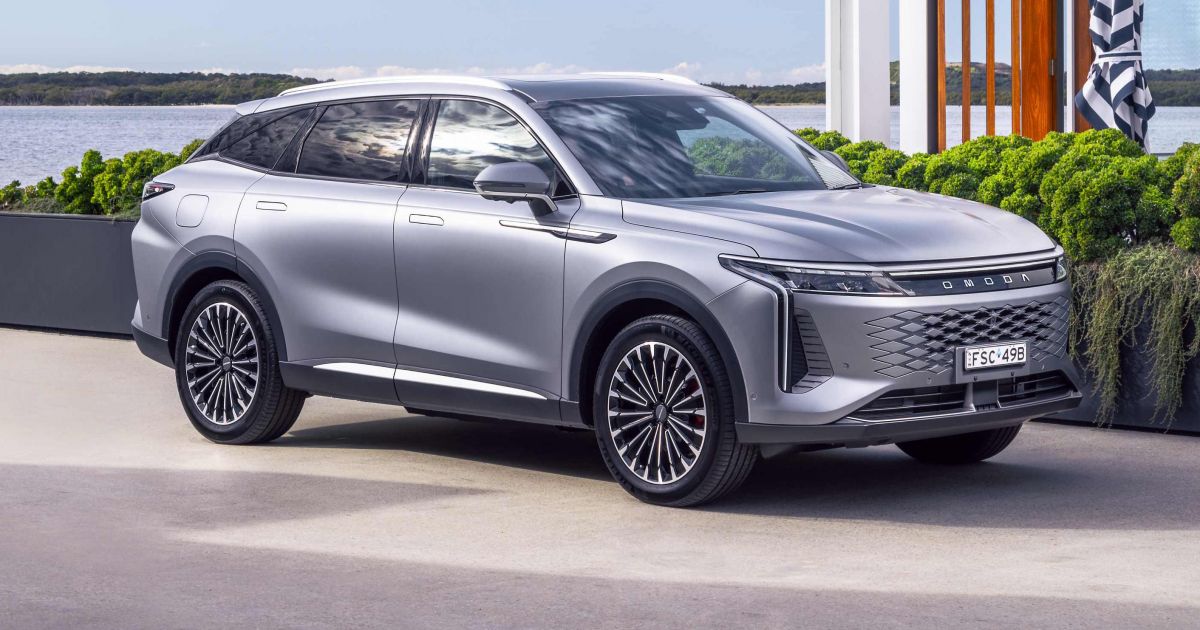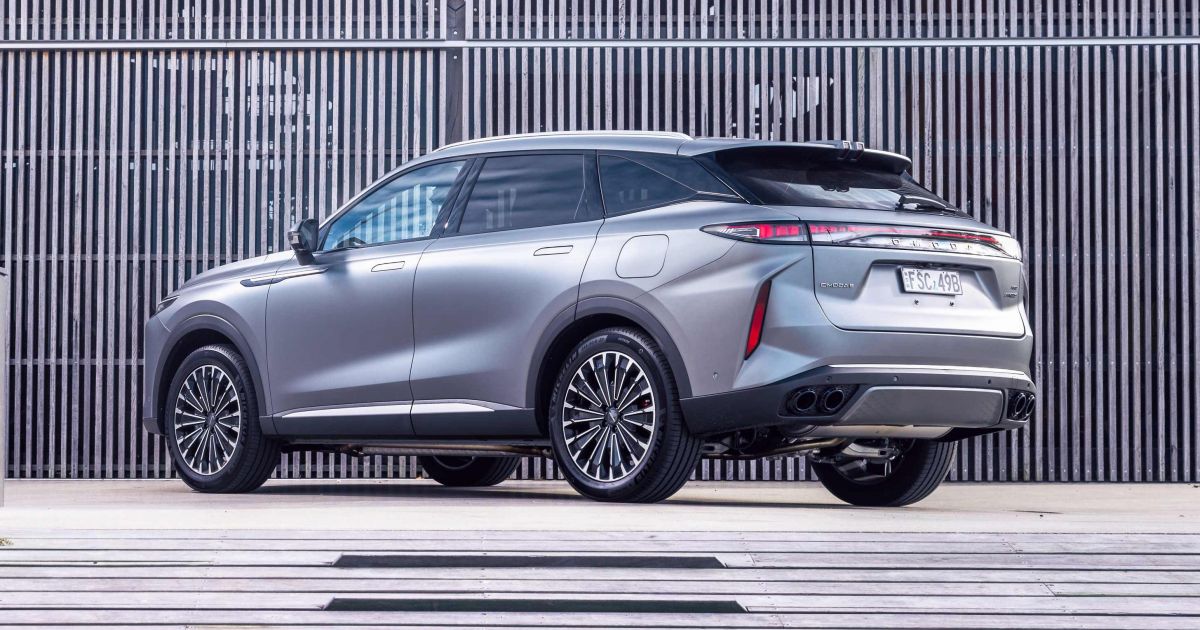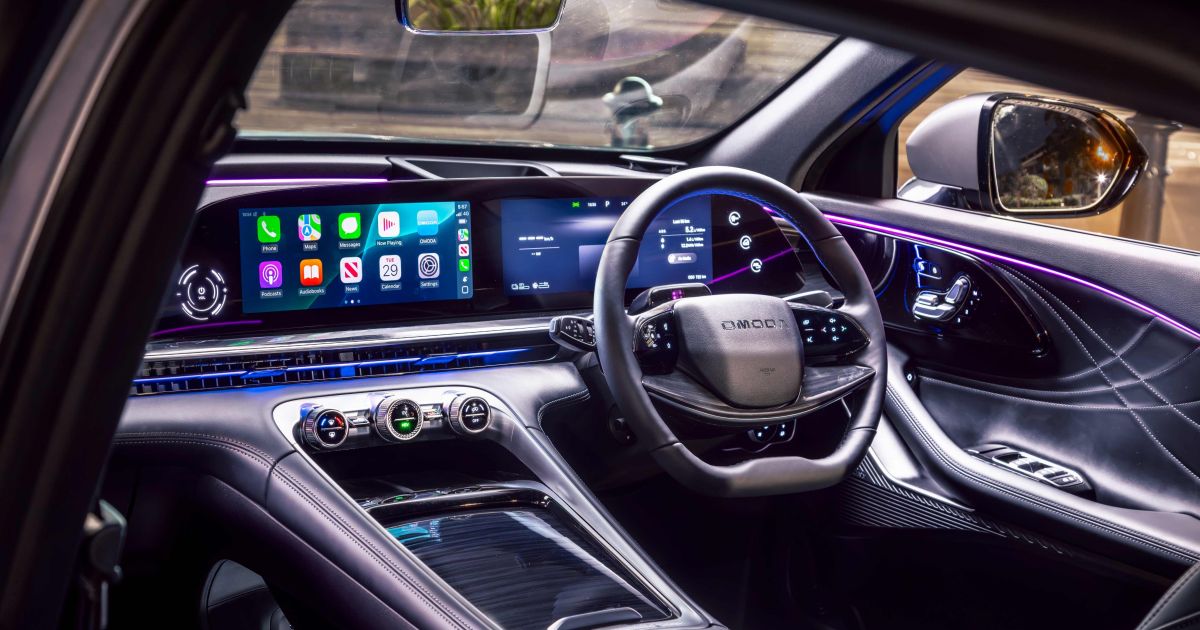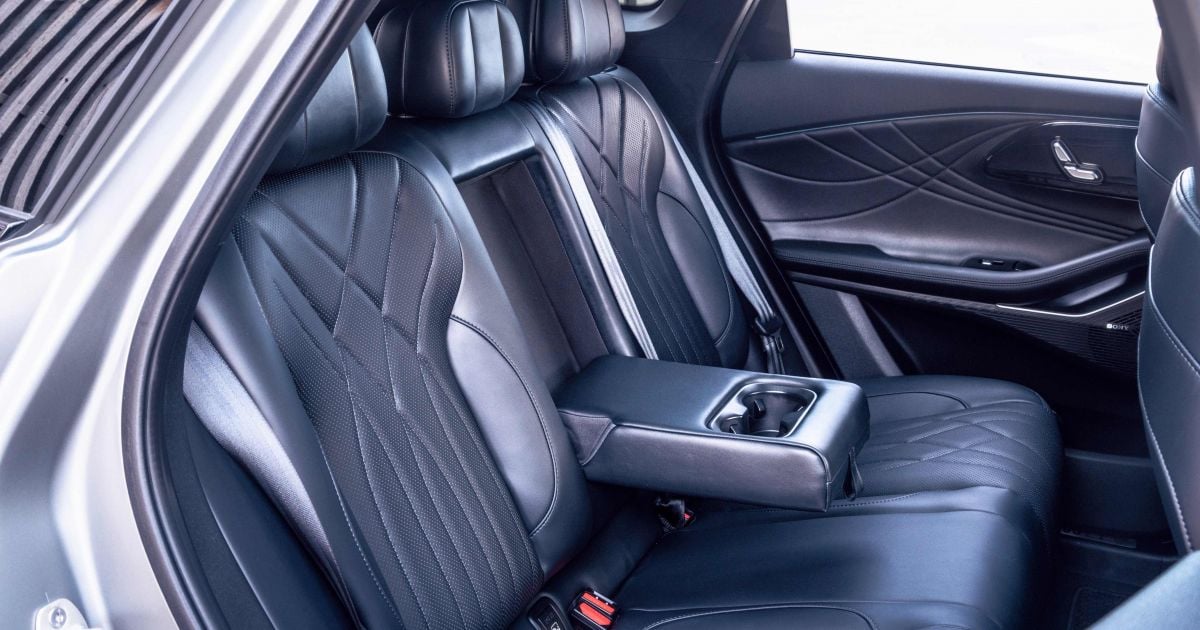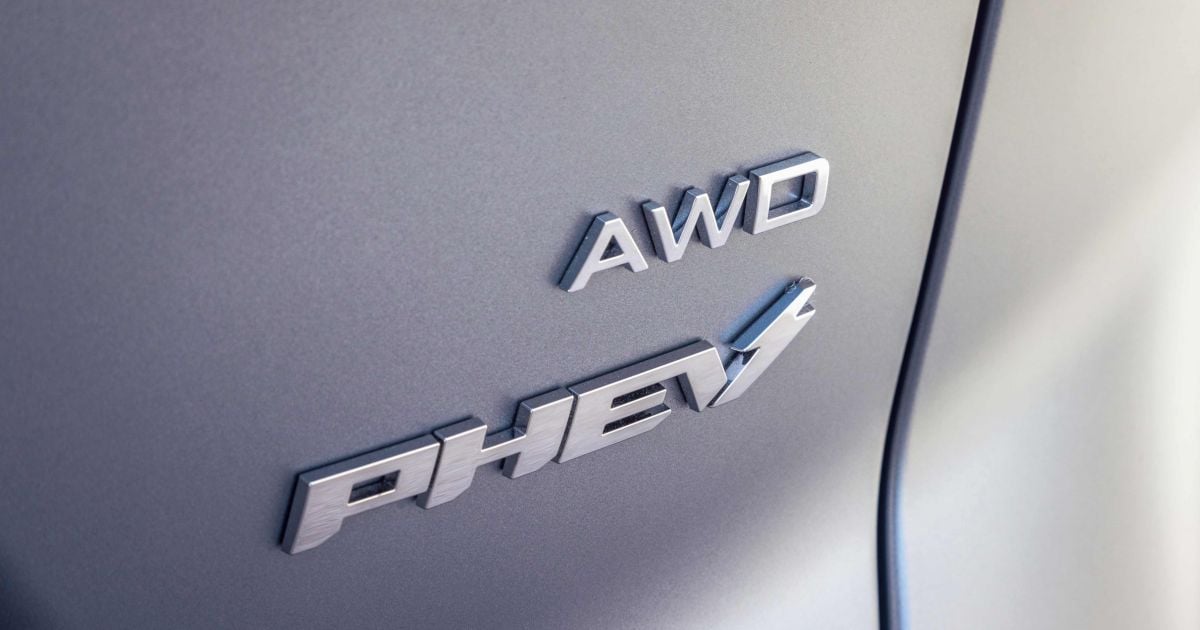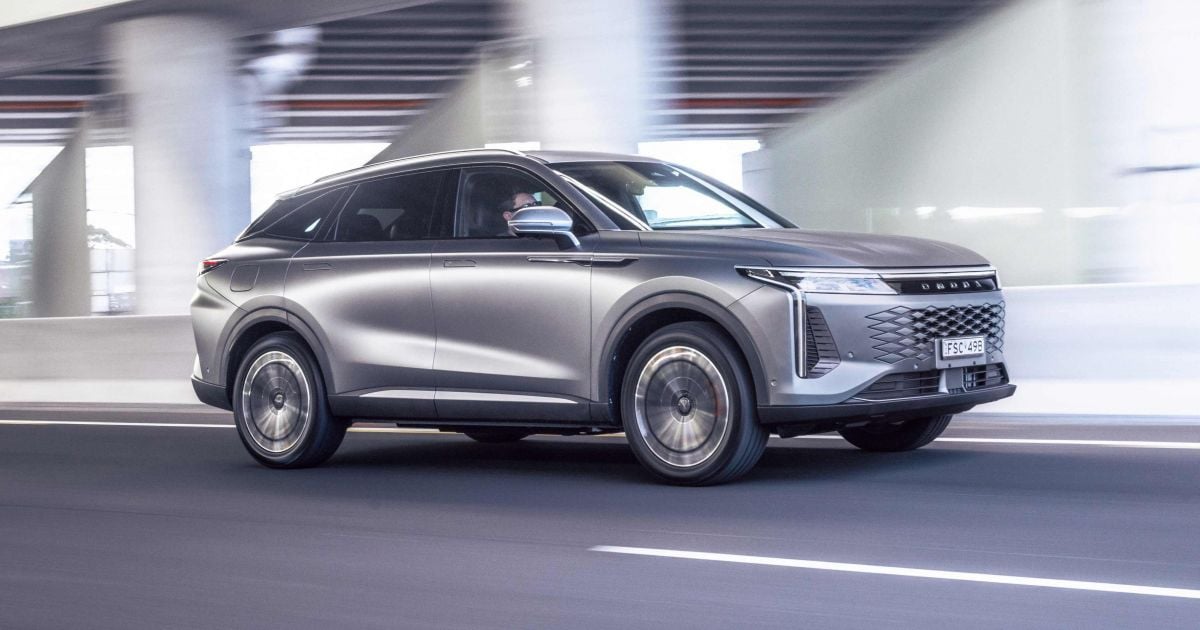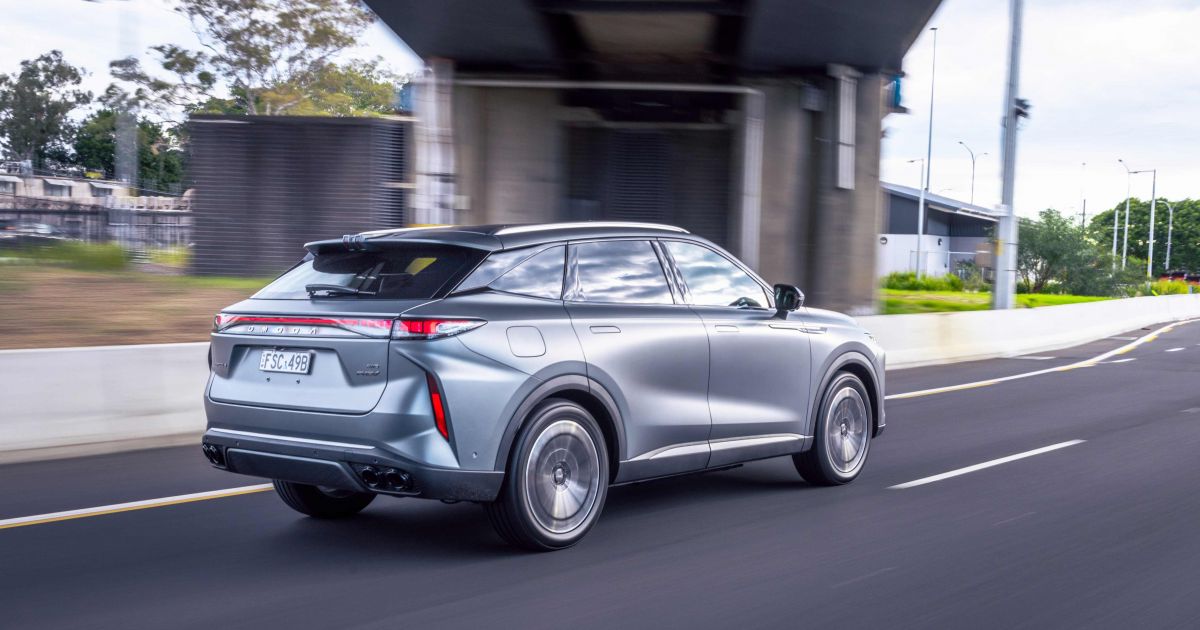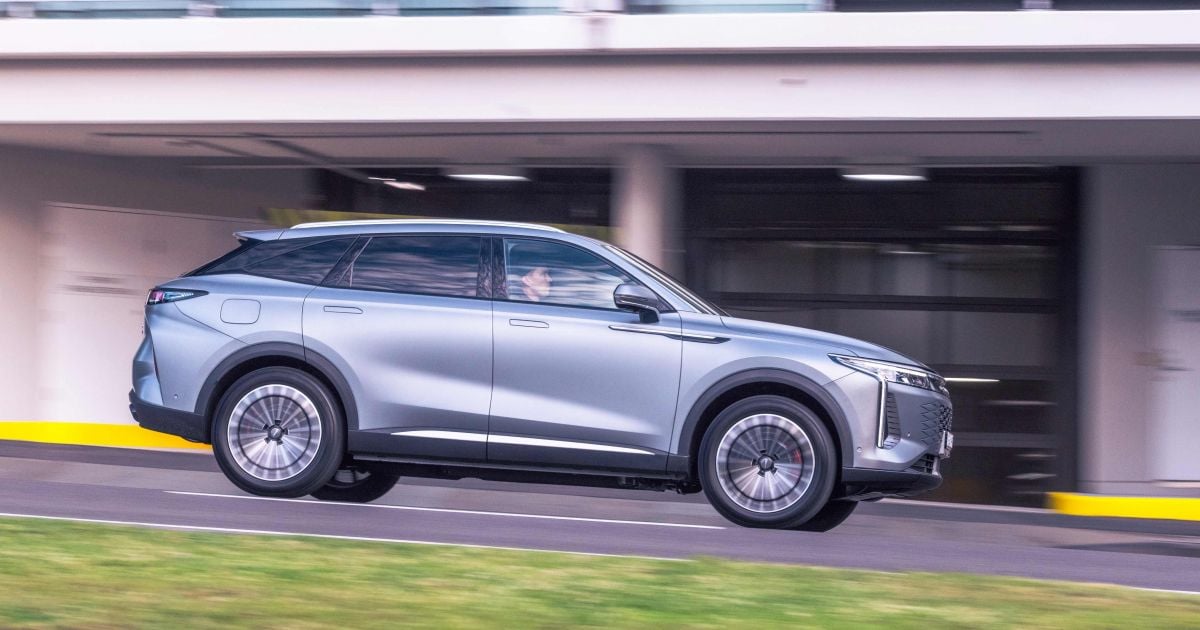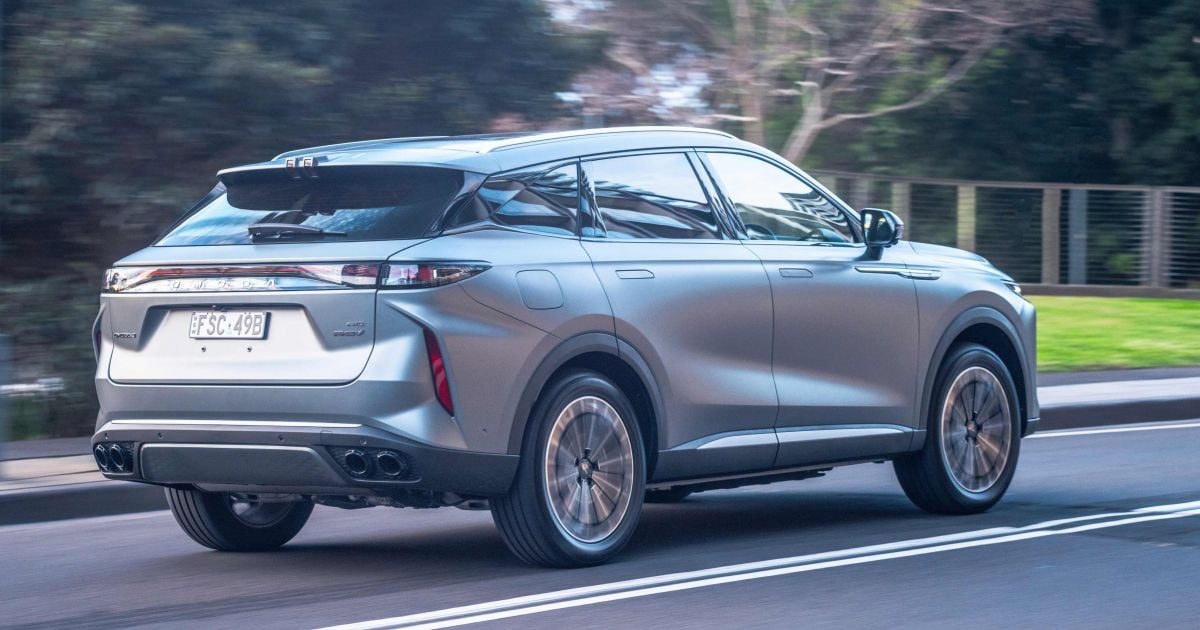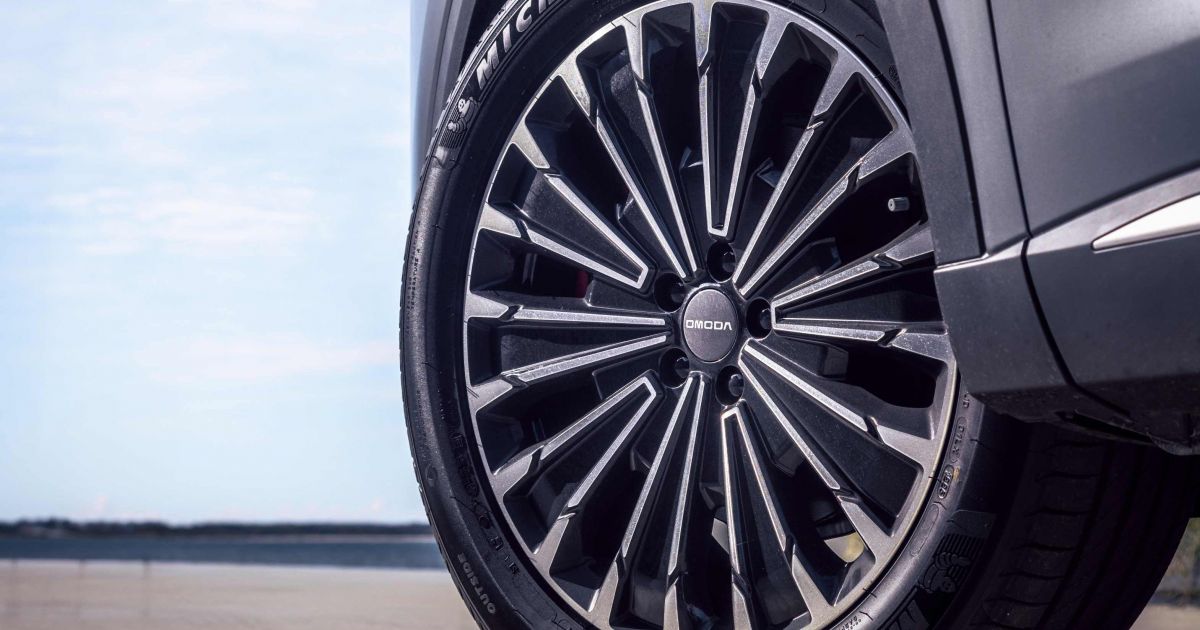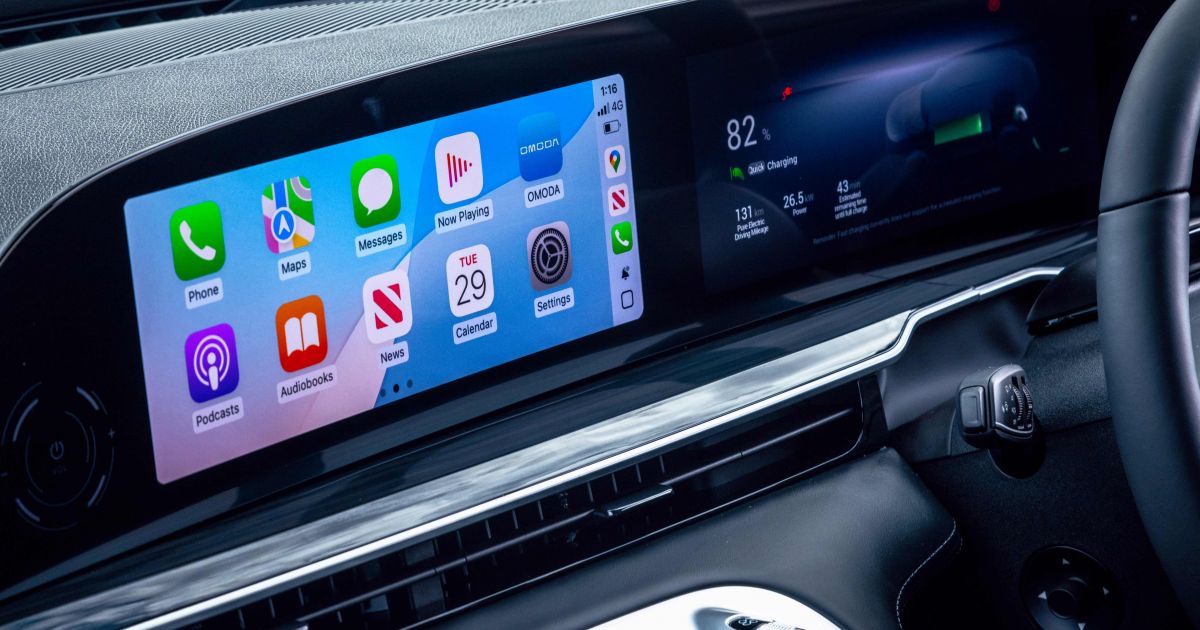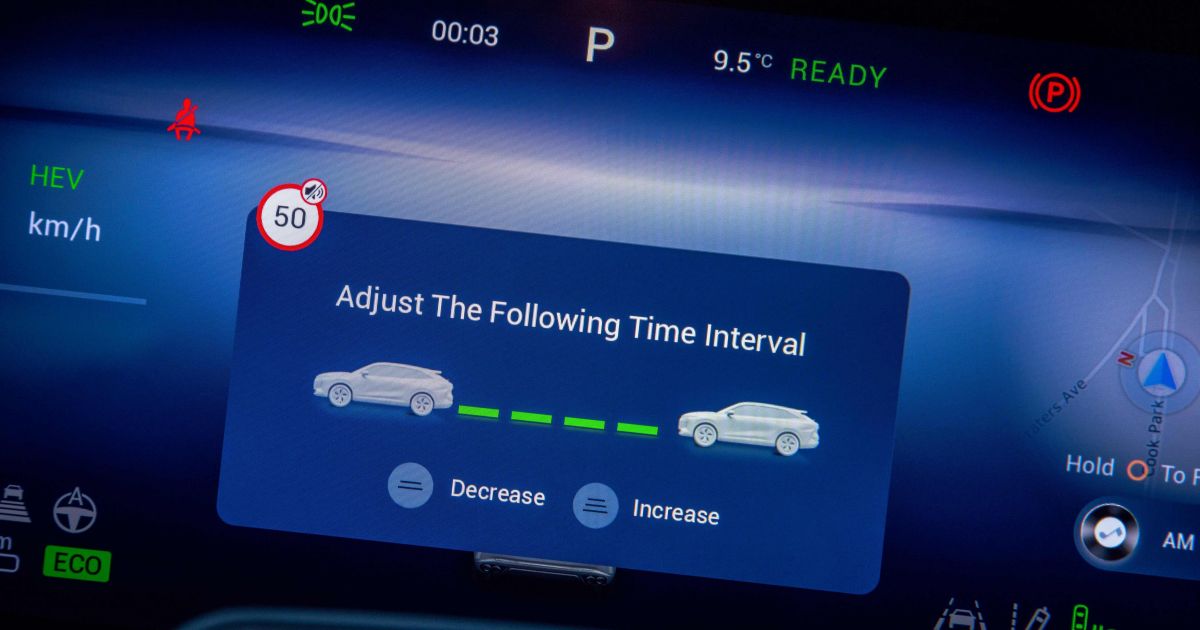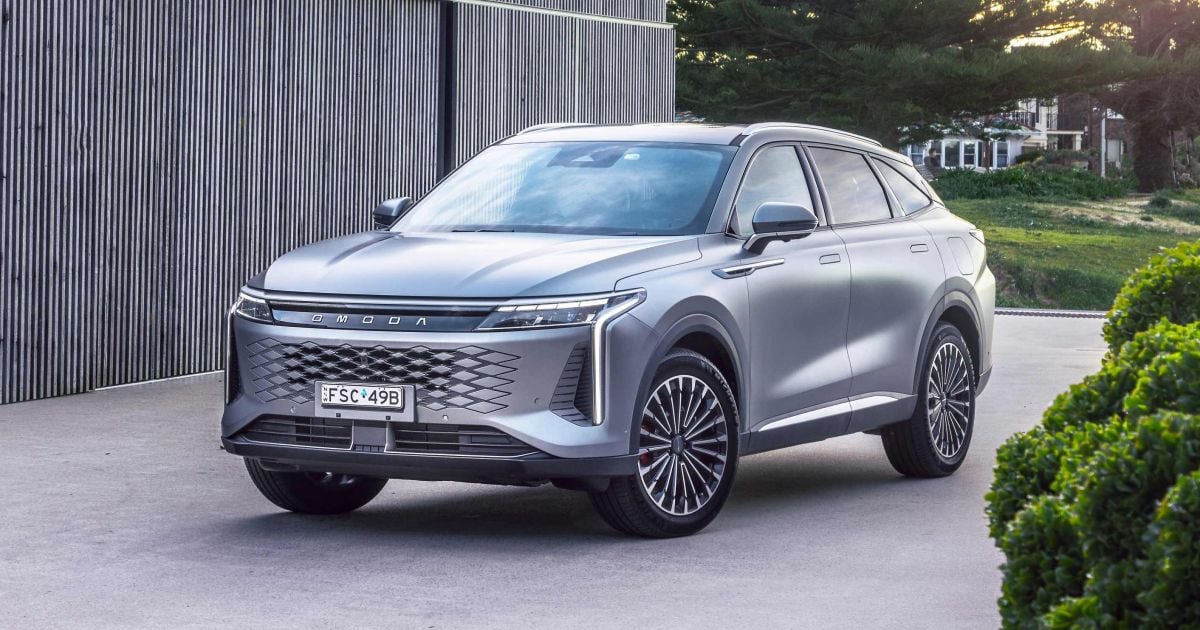The first Omoda-branded model offered in Australia, the Omoda 9, is a mid-to-large five-seat ‘premium’ SUV whose headline acts are a plug-in hybrid (PHEV) powertrain that outputs a big 395kW of power and pricing to compete with more expensive rivals.
Omoda says it’s pitched at the ‘EV curious’ and, while it’s new to Australia, the Omoda 9 has been on sale overseas under other Chery brands – such as Exceed, which is not offered here – since 2022.
Still, it boasts one of the most advanced versions of the company’s ‘Super Hybrid System’, which comprises a trio of electric motors, a petrol engine and a dedicated hybrid transmission.
The extensive standard equipment list includes leather seat trim, acoustic glass and auto parking, plus a large, curved digital display, plus a chassis aided by adaptive dampers designed to provide a more comfortable ride.
It stacks up well on paper, but does the fledgling Chinese brand deliver on its promise by offering a premium experience behind the wheel?
We attended the Omoda 9’s national media launch to find out.
How much does the Omoda 9 cost?
The Omoda 9 is only offered in one model grade, called Virtue, priced from $61,990 before on-road costs.
That’s close to similar-sized models such as the slightly smaller Mazda CX-60 PHEV and, although it’s a hybrid, it’s worth noting the Omoda 9 costs more than the entry-level battery-electric Zeekr 7X, which is also pitched as a premium model, and the top-selling Tesla Model Y.
| Model | Price before on-road costs |
|---|---|
| 2025 Omoda 9 Virtue | $61,990 |
To see how the Omoda stacks up against its rivals, use our comparison tool
What is the Omoda 9 like on the inside?
The upmarket Omoda 9 cabin offers perforated stitched leather seat and door trim, silver switches and a dark woodgrain-like appliqué – and even a thin wrap-around LED light strip – which combine to mimic older Mercedes-Benz interiors.
That includes the silver, door-mounted electric seat adjustment controls, the silver spiral-themed speaker grilles, and the built-in perfume diffuser to give the interior some fragrance.
The cabin’s presentation is cohesive and comfortable, but apart from the huge digital screens it looks a bit dated and doesn’t really offer any real design edginess, sense of occasion or opulence to set it apart from its competition.
There are some unique touches, though, such as the door-release buttons that are backed up by physical, mechanical door handles.
The driver’s seat is soft and comfortable but quite narrow, with this road tester forced to sit on the bolsters. It was also too high for me, with marginal headroom under the standard panoramic sunroof despite the flat-bottom steering wheel.
There are dual 12.3-inch screens, combined in a single curved display, as well as a decent-sized centre console offering space for two smartphones but wireless (50W) charging for just one.
Excellent textured circular dials for the air-conditioning sit at the front of the smartly designed centre console ‘bridge’, but the gloss black appliqué across the dash extends to the steering wheel buttons – there are single panels on each spoke – making them hard to read in bright sun.
A great touch is the built-in head restraint speakers for the front seats – something seen in cars such as the Mazda MX-5 and Zeekr 7X – making for clearer phone calls and instructions from the native sat-nav.
The second row – which has similar headroom limitations and narrowness, but great legroom – also has reclining and heated/ventilated outboard seats, plus air-conditioning vents in the B-pillars as well as the centre console.
The sizeable 660-litre cargo area – accessed by a powered tailgate and expanding to a generous 1783L with the rear seats stowed – has quite a high floor despite the lack of a spare wheel, but also a low loading lip. Payload is just 406kg and towing capacity is zero.
| Dimensions | Omoda 9 |
|---|---|
| Length | 4775mm |
| Width | 1920mm |
| Height | 1671mm |
| Wheelbase | 2800mm |
| Cargo capacity | 660L (to roof); 1783L (with rear seats folded; to roof) |
To see how the Omoda stacks up against its rivals, use our comparison tool
What’s under the bonnet?
The ‘Super Hybrid’ plug-in hybrid powertrain under the Omoda 9’s bonnet comprises a 1.5-litre four-cylinder direct-injection petrol engine making 105kW/215Nm, a trio of electric motors and all-wheel drive.
It’s a more complex and sophisticated setup than what’s offered in Chery and Jaecoo-badged hybrids currently available in Australia, and it has a claimed total driving range of 1100km and CO2 emissions of 34g/km.
The petrol engine can send drive to the wheels or act as a generator to top up the relatively large 34kWh nickel manganese cobalt battery, which allows the Omoda 9 to run on electric power only for up to 145km (WLTP).
This, says Omoda, means many drivers will rarely need to plug in the 9 to top up its battery, reducing range anxiety.
Two motors are mounted on the front axle, with one producing a claimed 75kW/170N and the other 90kW/200Nm. A third electric motor, making 175kW/310Nm, is fitted to the rear axle.
The headline power figure of 395kW – and the claimed 0-100km/h acceleration time of just 4.9 seconds – is only possible when the Omoda 9 is in Sport drive mode and has at least a 90 per cent battery charge.
Otherwise, outputs vary from “up to” 180kW in Eco mode and 220kW in Normal. Torque is directed to any of the four wheels via a hybrid-specific three-speed automatic transmission, and while the Omoda 9 is capable of running in rear-wheel drive, for example, you can’t select where the power is sent.
| Specifications | Omoda 9 |
|---|---|
| Engine | 1.5L turbo-petrol 4cyl |
| Engine outputs | 105kW + 215Nm |
| Electric motor outputs | (75kW + 170Nm) + (90kW + 220Nm) + (175kW + 310Nm) |
| System outputs | 395kW |
| Battery | 34kWh nickel manganese cobalt (NMC) |
| Transmission | 3-speed Dedicated Hybrid Transmission |
| Drive type | All-wheel drive |
| Weight | 2203kg |
| 0-100km/h (claimed) | 4.9 seconds |
| Fuel economy (claimed) | 1.4L/100km |
| Electric driving range | 145km (WLTP) |
| AC charging rate | 6.6kW |
| DC charging rate | 70kW |
| Fuel tank capacity | 70L |
| Fuel requirement | 95-octane premium unleaded |
| CO2 emissions | 32g/km |
To see how the Omoda stacks up against its rivals, use our comparison tool
How does the Omoda 9 drive?
While the Omoda 9 is offered in only a single model grade, we tested two different vehicles at the press launch and found they varied inexplicably in terms of driving finesse, which could have been down to tyre pressures.
Common to both vehicles was the high driving position and narrow driver’s seat, reducing headroom and comfort (at least for me) by a surprising amount for a large SUV. The high hip-point and heavily raked windscreen combine to allow a cyclist, for example, to be completely blocked by the rear-vision mirror.
The rear windscreen is slim, too, but rearward vision is not so bad, aided by good-sized mirrors which include blind-spot monitors. But we found the lane keep assist a little overbearing, despite Chery applying a local tune for the Omoda 9 after criticism of the ADAS performance in its self-branded vehicles.
There’s no engine start/stop or power off/on button: sensors in the driver’s seat and pedal pressure determine when the PHEV powertrain is ready to go, and the park brake won’t release unless the driver’s seatbelt is fastened.
From there, selecting Drive is done via a column-shifter on the right, and the Omoda 9 moves off in near silence in EV mode. That refinement remains as speed gathers, with seamless switching between electric and petrol power modes.
There’s a physical drive mode selector in the centre of the console – for choosing Eco, Normal, Sport and off-road settings including Sand and Snow. There’s also a switch to move between EV and HEV modes.
The powertrain remained refined around town, on the freeway and on country roads, so much so that at no time could we tell from the driver’s seat whether the engine or any of the three electric motors were actually running.
Powertrain performance varies depending on the drive mode, with the full 395kW only on tap in Sport mode, and only then when the battery is at 90 per cent of its capacity or more.
Power output is not only limited to 180kW in Eco and 220kW in Normal, but throttle response changes considerably between drive modes.
Steering and adaptive damper performance also changes noticeably depending on the drive mode selected.
In Normal, acceleration is easy to manage despite the storming amount of power available, but in Sport mode the sharpness of the powertrain becomes overbearing on winding roads, where you’d expect Sport to be the best choice.
That’s because the Omoda 9’s chassis could not seem to keep up with its powertrain performance, presenting significant nose lift under hard throttle applications – not wheelspin, but a lack of body control. This is no sports car and it’s not meant to be, but overly light and vague steering combined with low-grip Michelin Primacy ‘eco’ tyres mean its far from a corner-carver.
On narrow, twisty sections of road, the 9 was difficult to place with precision, while around town speed humps and even the smallest surface changes were clumsily telegraphed through the steering wheel. In both scenarios, the lack of body control produced a pitchy, bouncy ride as the big Omoda struggled to settle down.
The brakes vary in feel, too, with too much pedal travel before they start to bite, although amping up the braking energy regeneration system (which has three levels to choose from) improved this, enabling mostly one-pedal driving in traffic without neck-jarring ‘engine braking’ and the need to only occasionally use the brake pedal.
The vague steering also reduced confidence during parking, but this was somewhat countered by the crisp 360-degree camera and its excellent ‘see-through’ feature that gives you a view of what’s under the car, too.
It’s not supposed to be a driver’s car, but the 9 lacks the ride, handling and steering polish that a premium brand like Omoda is purporting to offer – and it doesn’t measure up to rivals with more humble ambitions.
What do you get?
The Omoda 9 Virtue is the only model grade offered in Australia.
2025 Omoda 9 equipment highlights:
- 20-inch alloy wheels in 245/50 R20 Michelin tyres
- Tyre repair kit
- Automatic projector LED headlights
- Automatic high beam
- Headlight height adjustment (through touchscreen)
- Heated, power-folding exterior mirrors
- Puddle lights
- Panoramic sunroof with power sunshade
- Power tailgate
- Proximity entry with push-button start
- Rain-sensing wipers
- Rear privacy glass
- Remote start
- Semi-autonomous parking assist
- Head-up display
- 12.3-inch digital instrument cluster
- 12.3-inch touchscreen infotainment system
- Wired and wireless Apple CarPlay, Android Auto
- Satellite navigation
- Digital radio
- 14-speaker Sony sound system (incl. two headrest speakers)
- 50W wireless phone charger
- Heated and ventilated front seats
- Heated and ventilated outboard rear seats
- 8-way power driver’s seat with thigh support extension
- 4-way power lumbar
- 4-way power passenger seat
- 60:40 split/fold rear seats
- Heated steering wheel
- Power tilt and telescopic steering wheel adjustment
- Dual-zone climate control
- Rear air vents (centre console and B-pillar)
- In-built fragrance system
- Colour-adjustable ambient lighting
- Built-in dashcam
- Alloy pedals
- 1 x front USB-A outlet
- 1 x front USB-C outlet
- 1 x rear USB-A outlet
- 1 x rear USB-C outlet
Is the Omoda 9 safe?
The Omoda 9 has a five-star Euro NCAP rating, which is expected to translate to the same rating from ANCAP in Australia and New Zealand, given the local independent auto safety body shares its data with its European counterpart.
Standard safety equipment includes:
- Autonomous emergency braking
- Blind-spot monitoring
- Driver attention monitoring
- Lane-keep assist
- Emergency lane-keep assist
- Integrated Cruise Assist
- Rear cross-traffic assist
- Safe exit warning
- Semi-autonomous parking assist
- Speed sign recognition
- Traffic Jam Assist
- Tyre pressure monitoring
- Front, rear and side parking sensors
- Surround-view camera
- 8 airbags
- 2 x front
- 2 x front-side
- 2 x curtain
- 1 x front centre
- 1 x driver’s knee
How much does the Omoda 9 cost to run?
Capped-price servicing for the duration of the eight-year, unlimited-kilometre warranty starts at $299 and ranges up to $750 for each 12-month service, totaling $3343 over eight years.
Despite its power and acceleration figures, the Omoda 9 has been designed for energy efficiency, with a relatively slippery 0.308Cd drag coefficient thanks in part to retractable exterior door handles, plus fuel-saving 20-inch tyres.
All that helps deliver an official combined fuel consumption figure of 1.4L/100km and energy consumption of 19.3kWh/100km, plus an electric only driving range of 130km (WLTP) from its big 34kWh battery, despite the vehicle weighing 2203kg.
Again, because the Super Hybrid System enables the petrol motor to provide drive as well as top-up the battery, we saw the battery charge reduce faster than the distance to empty during our drive.
This is because the petrol engine can top up the battery and enable the 9 to travel under electric power after repeated battery cycles before the 70-litre petrol tank runs dry.
The Omoda 9 cab be charged at up to 70kW, which allows for an 80 per cent charge in as little as 25 minutes.
| Servicing and Warranty | Omoda 9 |
|---|---|
| Warranty | 8 years, unlimited kilometres |
| Roadside assistance | 8 years |
| Service intervals | 12 months or 15,000 kilometres |
| Capped-price servicing | Up to 8 years |
| Total capped-price service cost | $3343 |
CarExpert’s Take on the Omoda 9
It may only have five seats, but the Omoda 9 is a handsome, refined and luxurious mid-size SUV that comes with solid safety credentials, a generous warranty, a long list of standard features and tech, and an equally long driving range from its powerful, seamless and efficient hybrid powertrain.
Yet, perhaps due to its age – and the pace of the Chinese auto industry – it’s not as convincing overall when you consider its similarly priced, sized and specified SUV rivals.
And while the Omoda 9 has solid on-paper credentials, its list price hike over many ‘cheap’ electrified Chinese SUVs is greater than the step up it is from them, despite being pushed into a premium playing field.
Our core dynamic criticism of the 9 is its lack of composure from behind the wheel, meaning the comfortable seats, excellent refinement and well laid-out cabin are let down by a bouncy, head-tossing ride for everyone on board.
The 9 is a solid first model for Chery’s Omoda brand in Australia, but there’s no hiding that it is indeed its first attempt.
Interested in buying an Omoda 9? Let CarExpert find you the best deal here
Click the images for the full gallery

